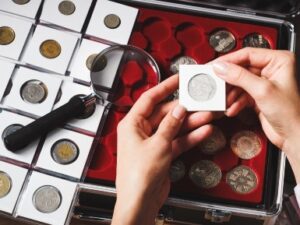
What’s It Worth: Coins and Value of Coin Collections
The technical name for collecting coins is Numismatic, which comes from the Latin word “nomisma,” meaning coin, and the Greek word “nomizien,” meaning to use. Therefore, coin collectors are known as Numismatists.
There are not a lot of Numismatists around these days. Many of our parents and grandparents were avid coin collectors, and their collections were often passed on to their children. Frequently, they were told that the coins “have a lot of value” or “will be worth a lot of money someday.” Many recipients of these gifts find themselves in a real quandary: they know that the coins were important to their previous owner, but they have little idea of the current value.
In most cases, younger generations do not collect coins. Scarcity is usually a good thing when it comes to collecting, except when it is collectors themselves who are rare. Today, there are far more coins in the market than there are collectors to buy them. That means that the numismatic value, or collectible value, of common coins, is often on the decline.
However, there may still be value in your collection. The good news is that the prices of silver and gold are high in today’s market, and most collections tend to contain one or both of these precious metals. As a result, many families have found selling their coins to be very rewarding.
Silver or Gold Coin Value
An interesting fact is that one dollar worth of dimes, quarters, or half dollars each has exactly .723 of a troy ounce of silver. Ten dimes contain the same amount of silver as four quarters, and four quarters have the equivalent of two half dollars. The coins are 90% silver and 10% copper and are therefore commonly referred to as 90% bulk silver coins by investors and collectors.
At today’s silver value, which is $21.11 at the time of this writing, a dollar total of any of these coins is worth $15.26. So, if you have $25 face value in silver coins today, it would be worth $381 in silver. That is a pretty nice return.
On the flip side, not every coin is collectible due to content alone. The majority of coins contain no silver or gold. The only value they have is their collectible value, and fortunately, most older U.S. coins still have some collectible demand, even if it isn’t what it used to be. But why don’t the coins minted today contain these precious metals?
In the early 60’s the value of silver was on the rise. Soon the silver value of dimes, quarters, and half dollars were worth more than the face value of the coins themselves. This rise in silver value, and therefore silver coin values, created a lot of coin collectors. People began to hold onto their silver coins, which led to a major coin shortage in 1963 and 1964. In response, the US Mint began using other, less valuable metals starting in 1965.
Common Coin Collections
Today, the most common coins I encounter in my clients’ collections include:
- Pennies
- Silver dimes, quarters, and half dollars.
- Silver dollars including Peace and Morgan designs.
- Indian head pennies
- Buffalo nickels
- US Mint sets
- US Mint commemoratives
There are, of course, countless other coins produced by the US mint, which we tend to find mixed in with many of the collections we work with. There are so many common coins struggling in value that when we do find a noteworthy coin, it is highly prized. It makes it that much more special when we do find something rare, knowing it can be worth more today than ever before.
Determining Coin Values
When determining value of currency, the most important aspects of a coin we look at are the series or design, age, mint it was produced in, and condition. We must check for signs that the coin has not been altered or cleaned. This is very important when it comes to this particular collectible. Never clean your coins.
Many collectibles can be enjoyed by others, such as art, sculptures, furniture, or antiques. These items can be seen by those who come into contact with them, but coins are usually hidden away in a box and tucked inside a closet, safe, or safety deposit box. Their original collector would have carefully curated them, spending time handling each coin, inspecting it with magnifying equipment for rare flaws or marks, and organizing it in their own unique system. Often the coins we find are in paper holders stapled on each side to secure it in place, with handwritten notes from the collector. Now that their curator is gone, the coins sit in the dark, unappreciated and serving no one.
I always encourage my clients to keep any coins that they like, and urge them to sell the rest. This way, they can benefit by any value the coins have, and the coins can be enjoyed by someone else as part of their collecting journey. Collectibles by their nature are intended to be enjoyed, prized, and valued. Your coins will be here long after you are gone, and it is better that you are the one who enjoys their value while you can.
If you want to sell your coins locally, try to seek out a reputable coin dealer in your area. Ideally, you should get a couple of offers on your coins before you sell them. Auction houses and estate sale specialists will offer to sell your coins, but you may be able to get a higher payout by dealing with a dedicated buyer. The great thing about coins is that they are easily shippable, and you can offer your collection at a national level as well. Feel free to check with us to start the process: charles@thekeysguild.com.
Charles Tinsley is a collectibles specialist and owner of The Keys Guild.





